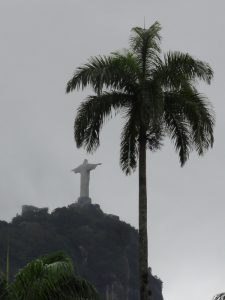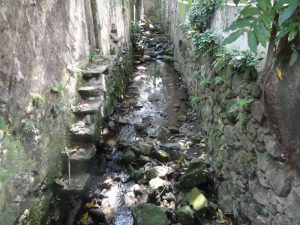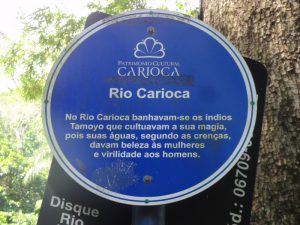 I’ve arrived in Rio de Janerio to prepare for our “situation”, taking place next week as part of the Multicidade International Festival of Women in Theatre. It’s my first visit to Rio, so as well as preparations I’m fitting in a little bit of sightseeing before what will be a very busy week. On Monday, we will start the workshop to create the performance; there are 5 local participants, and the online team will join as time zones allow.
I’ve arrived in Rio de Janerio to prepare for our “situation”, taking place next week as part of the Multicidade International Festival of Women in Theatre. It’s my first visit to Rio, so as well as preparations I’m fitting in a little bit of sightseeing before what will be a very busy week. On Monday, we will start the workshop to create the performance; there are 5 local participants, and the online team will join as time zones allow.
On the flight over, I read “Dancing with the Devil in the City of God”, by Brazilian journalist Juliana Barbassa. She writes about the period from 2010 when she returned from overseas to live in Rio, and explores the changing nature of the city in this period as it prepared for the football World Cup in 2014 and for the coming Olympics. It gives a thorough and very readable introduction to the city, its neighbourhoods and history, addressing the politicial, social, economic and environmental aspects, including the issue of water quality. I had already been looking for information about Rio Carioca, the river that gives its name to the people of Rio (Cariocas) and which was once the main source of water for the city, so it was great to read about Juliana’s search for it. Over time it has become polluted and more and more buried beneath the city; in 2002 a sewage treatment plant was installed across its mouth where it flows into Guanabara Bay – acknowledging that this once pristine river is sadly now little more than a sewer.
 Like Juliana, I was curious to see the Carioca, so I took some tips from her book and yesterday, when the festival arranged a driver for me to see various sights such as the obligatory Cristo, I asked to go to Largo do Boticário. This proved quite a challenge for my lovely driver, Fernandez. He had to ask the way three times before we finally came to a little cobblestone lane branching off a busy road. After a few metres we came into a beautiful old square dominated by a very dilapidated once-grand mansion and some large trees: an oasis of peace and quiet. The lane crosses a small culvert just before the square, in which runs the Carioca. It’s hardly the “copious river … of pure and crystalline waters” that the historian Sebastião da Rocha Pita described in 1730, but at least this far up in Rio’s hills it hasn’t yet become the sewer that it is at its mouth.
Like Juliana, I was curious to see the Carioca, so I took some tips from her book and yesterday, when the festival arranged a driver for me to see various sights such as the obligatory Cristo, I asked to go to Largo do Boticário. This proved quite a challenge for my lovely driver, Fernandez. He had to ask the way three times before we finally came to a little cobblestone lane branching off a busy road. After a few metres we came into a beautiful old square dominated by a very dilapidated once-grand mansion and some large trees: an oasis of peace and quiet. The lane crosses a small culvert just before the square, in which runs the Carioca. It’s hardly the “copious river … of pure and crystalline waters” that the historian Sebastião da Rocha Pita described in 1730, but at least this far up in Rio’s hills it hasn’t yet become the sewer that it is at its mouth.
 The Carioca’s presence here is marked by a sign that translates as “The Tamoios Indians bathed in the Rio Carioca and worshipped its magic, because according to their beliefs its water gave beauty to women and virility to men.” And in the centre of the square is a plaque that reads (in Portuguese): “You who live in this nook, blessed by waters & silence, remember that the enchantment of this place depends on you.” Clearly, these messages have been forgotten for a long time.
The Carioca’s presence here is marked by a sign that translates as “The Tamoios Indians bathed in the Rio Carioca and worshipped its magic, because according to their beliefs its water gave beauty to women and virility to men.” And in the centre of the square is a plaque that reads (in Portuguese): “You who live in this nook, blessed by waters & silence, remember that the enchantment of this place depends on you.” Clearly, these messages have been forgotten for a long time.
Fernandez was quite bemused by me wanting to visit Largo do Boticário; he doesn’t speak any English beyond a few words, and my Portuguese is about the same, so he was concerned that he’d misunderstood me and called Jadranka to clarify. Through her translation I managed to reassure him that we were exactly where I wanted to be. In her book, Juliana says that most Cariocas (people of Rio) don’t know about Rio Carioca – which surprised me, as I would have thought they’d know the origin of the name just as we kiwis know what a kiwi really is. I tried to ask Fernando if he knew the story, but I failed to communicate. A little later, as we paused in the lovely neighbourhood of Santa Teresa, we had better success at communication when I invited him to have coffee. Coffee is much more universal than complex questions about history and identity!
Today I continued my research, meeting three of the women from Haveté Sustentabilidade, who have been helping me with the research and on Friday will take me on a boat tour with local fisherman, to visit some of the sites of pollution and problems around Guanabara Bay. We got to know each other, discussed the project and made plans for Friday’s expedition and the coming week’s workshop and performance. I also visited the festival venue, Espaço Tom Jobim (Tom Jobim was a Brazilian musician who pioneered bossa nova and composed “The Girl from Ipanema), where I saw the spaces we will use for the workshop and performance, and met with the technicians – who all seem very nice and obliging with my requests for ethernet cables, laptops and data projectors. My new best friends!